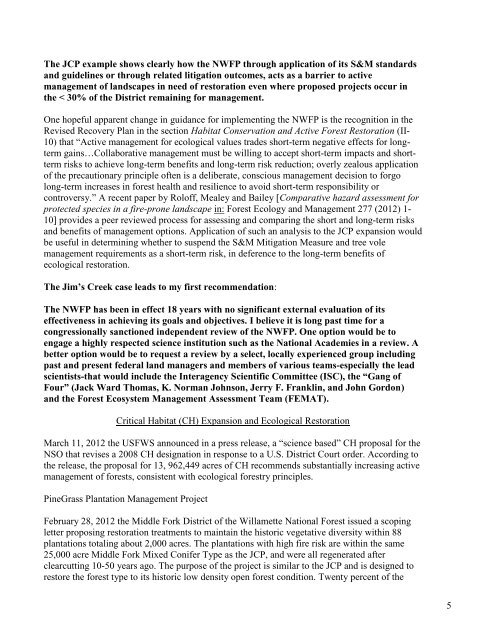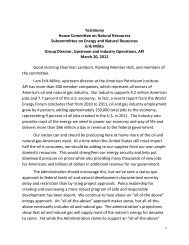Mr. Stephen Mealey - The House Committee on Natural Resources ...
Mr. Stephen Mealey - The House Committee on Natural Resources ...
Mr. Stephen Mealey - The House Committee on Natural Resources ...
Create successful ePaper yourself
Turn your PDF publications into a flip-book with our unique Google optimized e-Paper software.
<str<strong>on</strong>g>The</str<strong>on</strong>g> JCP example shows clearly how the NWFP through applicati<strong>on</strong> of its S&M standards<br />
and guidelines or through related litigati<strong>on</strong> outcomes, acts as a barrier to active<br />
management of landscapes in need of restorati<strong>on</strong> even where proposed projects occur in<br />
the < 30% of the District remaining for management.<br />
One hopeful apparent change in guidance for implementing the NWFP is the recogniti<strong>on</strong> in the<br />
Revised Recovery Plan in the secti<strong>on</strong> Habitat C<strong>on</strong>servati<strong>on</strong> and Active Forest Restorati<strong>on</strong> (II-<br />
10) that “Active management for ecological values trades short-term negative effects for l<strong>on</strong>gterm<br />
gains…Collaborative management must be willing to accept short-term impacts and shortterm<br />
risks to achieve l<strong>on</strong>g-term benefits and l<strong>on</strong>g-term risk reducti<strong>on</strong>; overly zealous applicati<strong>on</strong><br />
of the precauti<strong>on</strong>ary principle often is a deliberate, c<strong>on</strong>scious management decisi<strong>on</strong> to forgo<br />
l<strong>on</strong>g-term increases in forest health and resilience to avoid short-term resp<strong>on</strong>sibility or<br />
c<strong>on</strong>troversy.” A recent paper by Roloff, <str<strong>on</strong>g>Mealey</str<strong>on</strong>g> and Bailey [Comparative hazard assessment for<br />
protected species in a fire-pr<strong>on</strong>e landscape in: Forest Ecology and Management 277 (2012) 1-<br />
10] provides a peer reviewed process for assessing and comparing the short and l<strong>on</strong>g-term risks<br />
and benefits of management opti<strong>on</strong>s. Applicati<strong>on</strong> of such an analysis to the JCP expansi<strong>on</strong> would<br />
be useful in determining whether to suspend the S&M Mitigati<strong>on</strong> Measure and tree vole<br />
management requirements as a short-term risk, in deference to the l<strong>on</strong>g-term benefits of<br />
ecological restorati<strong>on</strong>.<br />
<str<strong>on</strong>g>The</str<strong>on</strong>g> Jim’s Creek case leads to my first recommendati<strong>on</strong>:<br />
<str<strong>on</strong>g>The</str<strong>on</strong>g> NWFP has been in effect 18 years with no significant external evaluati<strong>on</strong> of its<br />
effectiveness in achieving its goals and objectives. I believe it is l<strong>on</strong>g past time for a<br />
c<strong>on</strong>gressi<strong>on</strong>ally sancti<strong>on</strong>ed independent review of the NWFP. One opti<strong>on</strong> would be to<br />
engage a highly respected science instituti<strong>on</strong> such as the Nati<strong>on</strong>al Academies in a review. A<br />
better opti<strong>on</strong> would be to request a review by a select, locally experienced group including<br />
past and present federal land managers and members of various teams-especially the lead<br />
scientists-that would include the Interagency Scientific <str<strong>on</strong>g>Committee</str<strong>on</strong>g> (ISC), the “Gang of<br />
Four” (Jack Ward Thomas, K. Norman Johns<strong>on</strong>, Jerry F. Franklin, and John Gord<strong>on</strong>)<br />
and the Forest Ecosystem Management Assessment Team (FEMAT).<br />
Critical Habitat (CH) Expansi<strong>on</strong> and Ecological Restorati<strong>on</strong><br />
March 11, 2012 the USFWS announced in a press release, a “science based” CH proposal for the<br />
NSO that revises a 2008 CH designati<strong>on</strong> in resp<strong>on</strong>se to a U.S. District Court order. According to<br />
the release, the proposal for 13, 962,449 acres of CH recommends substantially increasing active<br />
management of forests, c<strong>on</strong>sistent with ecological forestry principles.<br />
PineGrass Plantati<strong>on</strong> Management Project<br />
February 28, 2012 the Middle Fork District of the Willamette Nati<strong>on</strong>al Forest issued a scoping<br />
letter proposing restorati<strong>on</strong> treatments to maintain the historic vegetative diversity within 88<br />
plantati<strong>on</strong>s totaling about 2,000 acres. <str<strong>on</strong>g>The</str<strong>on</strong>g> plantati<strong>on</strong>s with high fire risk are within the same<br />
25,000 acre Middle Fork Mixed C<strong>on</strong>ifer Type as the JCP, and were all regenerated after<br />
clearcutting 10-50 years ago. <str<strong>on</strong>g>The</str<strong>on</strong>g> purpose of the project is similar to the JCP and is designed to<br />
restore the forest type to its historic low density open forest c<strong>on</strong>diti<strong>on</strong>. Twenty percent of the<br />
5
















